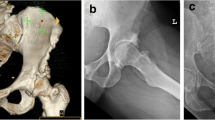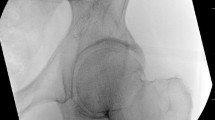Abstract
Purpose
With further understanding of the function and the importance of the hip labrum, greater attention has been paid to preserve and repair the damaged labrum. Hip labrum reconstruction has been described to optimize hip preservation when the labrum is deficient. This systematic review aimed to explore and identify the reported indications and outcomes in patients who undergo labral reconstruction of the hip joint.
Methods
The electronic databases EMBASE, MEDLINE, and PubMed were searched for all available dates up to July 2013. Further hand search of the reference sections of the included studies was done. Two reviewers searched, screened, and evaluated the included studies for data quality using the Methodological Index for Non-Randomized Studies (MINORS) Scale. Data were also abstracted in duplicate, and agreement and descriptive statistics are presented.
Results
There were 5 eligible studies (3 case series, 1 prospective cohort, and 1 retrospective chart review) with a total of 128 patients, and an average 11/16 quality on the MINORS score included in this review. All patients were diagnosed with femoroacetabular impingement and underwent labral reconstruction. Ninety-four patients were assessed at follow-up (73.4 % survivorship) between a reported mean range of 10 and 49 months. There was variability between the studies with regard to the graft types utilized (ilio-tibial band, Gracilis tendon, Ligamentum teres), surgical approaches [open (18.7 %) vs. arthroscopic (81.3 %)], and the reported outcome measures. Overall, improvement was observed in the patient-reported outcomes and functional scores (mHHS, HOS, UCLA, NASH, and SF-12). The failure rate or conversion to THA rate in all available patients was 20 %. The most common indication for labrum reconstruction was a young, active patient with minimal arthritis and non-salvageable or deficient labrum. Other indications included instability, pain, and hypotrophic dysfunctional labrum.
Conclusion
Based on the current available evidence, hip labrum reconstruction is a new technique that shows short-term improvement in patient-reported outcomes and functional scores post-operatively. The main indication for reconstruction was a deficient labrum due to previous surgical excision or irreparable tears in young patients with no significant arthritis. Long-term follow-up results with higher quality studies are still lacking based on this review.
Level of evidence
II.

Similar content being viewed by others
References
Benali Y, Katthagen BD (2009) Hip subluxation as a complication of arthroscopic debridement. Arthroscopy 25(4):405–407
Boykin RE, Patterson D, Briggs KK, Dee A, Philippon MJ (2013) Results of arthroscopic labral reconstruction of the hip in elite athletes. Am J Sports Med 41(10):2296–2301
Cadet E, Chan A, Vorys G, Gardner T, Yin B (2012) Investigation of the preservation of the fluid seal effect in the repaired, partially resected, and reconstructed acetabular labrum in a cadaveric hip model. Am J Sports Med 40(10):2218–2223
Crawford MJ, Dy CJ, Alexander JW, Thompson M, Schroder SJ, Vega CE, Patel RV, Miller AR, McCarthy JC, Lowe WR, Noble PC (2007) The 2007 Frank Stinchfield Award. The biomechanics of the hip labrum and the stability of the hip. Clin Orthop Relat Res 465:16–22
Ejinsman L, Philippon MJ (2011) Arthroscopic labral reconstruction in the hip using iliotibial band autograft. Oper Tech Sports Med 19(2):134–139
Ejnisman L, Philippon MJ, Lertwanich P (2011) Acetabular labral tears: diagnosis, repair, and a method for labral reconstruction. Clin Sports Med 30(2):317–329
Espinosa N, Rothenfluh DA, Beck M, Ganz R, Leunig M (2006) Treatment of femoro-acetabular impingement: preliminary results of labral refixation. J Bone Joint Surg Am 88(5):925–935
Ferguson SJ, Bryant JT, Ganz R, Ito K (2003) An in vitro investigation of the acetabular labral seal in hip joint mechanics. J Biomech 36(2):171–178
Ferguson SJ, Bryant JT, Ganz R, Ito K (2000) The influence of the acetabular labrum on hip joint cartilage consolidation: a poroelastic finite element model. J Biomech 33(8):953–960
Geyer MR, Philippon MJ, Fagrelius TS, Briggs KK (2013) Acetabular labral reconstruction with an iliotibial band autograft: outcome and survivorship analysis at minimum 3-year follow-up. Am J Sports Med 41(8):1750–1756
Greaves LL, Gilbart MK, Yung AC, Kozlowski P, Wilson DR (2010) Effect of acetabular labral tears, repair and resection on hip cartilage strain: a 7T MR study. J Biomech 43(5):858–863
Larson CM, Giveans MR (2009) Arthroscopic debridement versus refixation of the acetabular labrum associated with femoroacetabular impingement. Arthroscopy 25(4):369–376
Matsuda DK, Burchette RJ (2013) Arthroscopic hip labral reconstruction with a gracilis autograft versus labral refixation: 2-year minimum outcomes. Am J Sports Med 41(5):980–987
Matsuda DK (2009) Acute iatrogenic dislocation following hip impingement arthroscopic surgery. Arthroscopy 25(4):400–404
McGinn T, Wyer PC, Newman TB, Keitz S, Leipzig R, For GG, Evidence-Based Medicine Teaching Tips Working Group (2004) Tips for learners of evidence-based medicine: 3 measures of observer variability (kappa statistic). CMAJ 171(11):1369–1373
Philippon MJ, Briggs KK, Hay CJ, Kuppersmith DA, Dewing CB, Huang MJ (2010) Arthroscopic labral reconstruction in the hip using iliotibial band autograft: technique and early outcomes. Arthroscopy 26(6):750–756
Philippon MJ, Briggs KK, Yen YM, Kuppersmith DA (2009) Outcomes following hip arthroscopy for femoroacetabular impingement with associated chondrolabral dysfunction: minimum two-year follow-up. J Bone Joint Surg Br 91(1):16–23
Schenker ML, Philippon MJ (2010) Acetabular labral tears: resection vs. repair. UPOJ 20:83–87
Sierra RJ, Trousdale RT (2009) Labral reconstruction using the ligamentum teres capitis: report of a new technique. Clin Orthop Relat Res 467(3):753–759
Slim K, Nini E, Forestier D, Kwiatkowski F, Panis Y, Chipponi J (2003) Methodological index for non-randomized studies (minors): development and validation of a new instrument. ANZ J Surg 73(9):712–716
Walker JA, Pagnotto M, Trousdale RT, Sierra RJ (2012) Preliminary pain and function after labral reconstruction during femoroacetabular impingement surgery. Clin Orthop Relat Res 470(12):3414–3420
Acknowledgments
No funding was received for the completion of this manuscript.
Conflict of interest
None.
Author information
Authors and Affiliations
Corresponding author
Rights and permissions
About this article
Cite this article
Ayeni, O.R., Alradwan, H., de Sa, D. et al. The hip labrum reconstruction: indications and outcomes—a systematic review. Knee Surg Sports Traumatol Arthrosc 22, 737–743 (2014). https://doi.org/10.1007/s00167-013-2804-5
Received:
Accepted:
Published:
Issue Date:
DOI: https://doi.org/10.1007/s00167-013-2804-5




